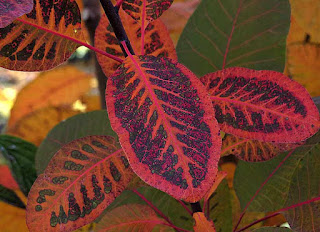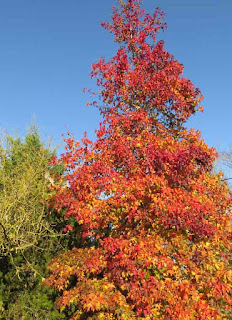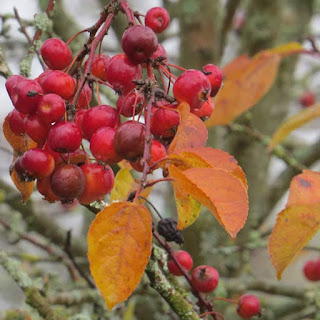"The tide rises, the tide falls
The twilight darkens, the curlew calls..."
- H W Longfellow
 |
| Ebb tide on the Gironde near Meschers |
Winter evenings can often produce spectacular sunsets and even the mudflats become photogenic, dotted with grassy islets and silhouetted shore birds.
The bubbling call of the curlew is particularly atmospheric and distinguishes it immediately from the similar-looking whimbrel, another bird with a curved bill which feeds along this coast.
 |
| A new carpet of ash leaves on the driveway |
I also find it's a useful warm-up task to get my arms and shoulders working before tackling more constrained jobs like weeding and planting that tend to give me neck ache.
 |
| A good rake makes leaf-clearance a pleasure! |
We also have a useful rubber rake which takes care of leaves on the gravel driveway and in plant borders where you need a gentler action - and less sharp tines.
It's not until you're forced to try a new version of an old favourite that you realise how much a standard tool can be improved over the years, especially as they tend to be more lightweight and rust-proof these days.
 |
| Red leaves of Cotinus coggygria (left) and Physocarpus opulifolius (right) |
Wielding this new rake, I can clear our leaves in half the time and with much less effort than before, dumping as many as possible into a caged area to attract worms and become rich leaf-mould.
The remaining ash leaves, which are pretty small anyway, can be heaped up under trees and shrubs where they will rot down naturally over winter and provide a mulch to help alleviate some of the dryness.
 |
| Cotinus coggygria or smoke bush is a must-have for its dramatic leaf colour, in spring and autumn |
 |
| Yellow field maple and young liquidambar |
In addition to natives like the ash and field maple (left) he has recently transplanted a number of lovely young liquidambar trees which were growing in his nursery area.
Sometimes these autumnal tints are so bright that I almost prefer photographing them on a foggy day when their colours are gentler and more painterly...
 |
| Liquidambar styraciflua or Sweet Gum tree - dressed to kill |
Liquidambar styraciflua
But if you want colour that will blow your socks off then this is definitely the tree for you!
Once she puts on her scarlet ballgown, this lady doesn't keep her foliage for long and you have to be quick to get photo's.
Even as a small tree, the shiny red leaves are eyecatching (see above) and resemble those of a maple in shape.
Its foliage changes colour dramatically from purple through to red, followed by a rich golden yellow - and then the leaves drop, rolling out a carpet every bit as luxuriant.
This is a tree which can grow up to 20 meters tall and originated in the eastern US.
There are now several named varieties, such as 'Worplesdon', as recommended by the RHS, and they will grow in any reasonably moist soil so long as it's lime-free.
The flowers are insignificant but it does produce globular, spiky autumn fruits which are left to decorate the bare branches once its leaves have disappeared.
Crabapple Trees
Because of their more compact size, the flowering crabs or crabapples are more suitable for a small garden and I wish we'd planted one in our hedgerow as the fruits seem to be very popular with birds.
As it blossoms quite early in spring, the nectar also attracts bees and other insects which help to pollinate any regular apple trees you may have.
Wild crabapple, Malus sylvestris, is becoming rare in British hedgerows but it's well worth planting an ornamental variety in your garden.
Butterflies are getting scarcer now but a reliable forager at this time of year is the clouded yellow, seen here feeding on an autumn hawkbit (Leontodon autumnalis) which is flowering in many of our vineyards, together with the wild marigold whose pretty orange blooms brighten up many a misty morning.
Other butterflies still on the wing tend to be species like the red admiral which hibernate during winter.
Salvias
We now have several varieties of ornamental sage which provide us with plenty of vibrant colour from early summer up to the first frosts.
One of the last to come into bloom is the exotic Salvia leucantha from Mexico with its long, furry flower spikes resembling purple caterpillars!
Although we mulch the plant with leaves, it can easily be killed in a hard frost so it's advisable to take cuttings and protect them over winter.
Two other Mexican sages are still performing vigorously: the late-blooming Salvia elegans in our sunny front garden has been in flower for over a month; and the smaller Salvia coccinea in the back border has continued flowering for several months despite a distinct lack of direct sun.
Once she puts on her scarlet ballgown, this lady doesn't keep her foliage for long and you have to be quick to get photo's.
Even as a small tree, the shiny red leaves are eyecatching (see above) and resemble those of a maple in shape.
Its foliage changes colour dramatically from purple through to red, followed by a rich golden yellow - and then the leaves drop, rolling out a carpet every bit as luxuriant.
 |
| Liquidambar leaves |
This is a tree which can grow up to 20 meters tall and originated in the eastern US.
There are now several named varieties, such as 'Worplesdon', as recommended by the RHS, and they will grow in any reasonably moist soil so long as it's lime-free.
The flowers are insignificant but it does produce globular, spiky autumn fruits which are left to decorate the bare branches once its leaves have disappeared.
Crabapple Trees
 |
| Female blackbird samples some ripe crabapples |
As it blossoms quite early in spring, the nectar also attracts bees and other insects which help to pollinate any regular apple trees you may have.
Wild crabapple, Malus sylvestris, is becoming rare in British hedgerows but it's well worth planting an ornamental variety in your garden.
 |
| Malus floribunda or Ornamental Crabapple - beautifully tinted leaves and abundant fruit |
 |
| Clouded yellow butterfly |
Other butterflies still on the wing tend to be species like the red admiral which hibernate during winter.
 |
| Mexican Bush Sage (Salvia leucantha) |
We now have several varieties of ornamental sage which provide us with plenty of vibrant colour from early summer up to the first frosts.
One of the last to come into bloom is the exotic Salvia leucantha from Mexico with its long, furry flower spikes resembling purple caterpillars!
Although we mulch the plant with leaves, it can easily be killed in a hard frost so it's advisable to take cuttings and protect them over winter.
 |
| Iberis sempervirens 'Snowflake' |
Although this area is in permanent shade from late September until spring, we still manage to get colour from a few roses, the odd Salvia microphylla, and now some Iberis sempervirens has come into full flower.
 |
| Ornamental pear trees (Pyrus calleryana) holding onto their vivid colours until the temperatures plunge |















